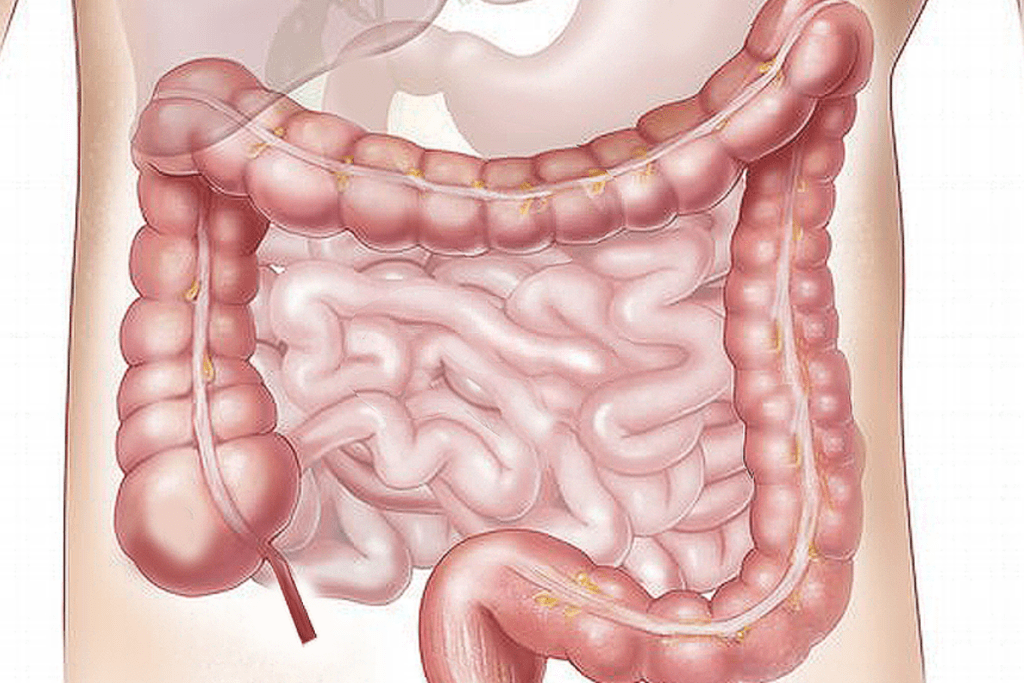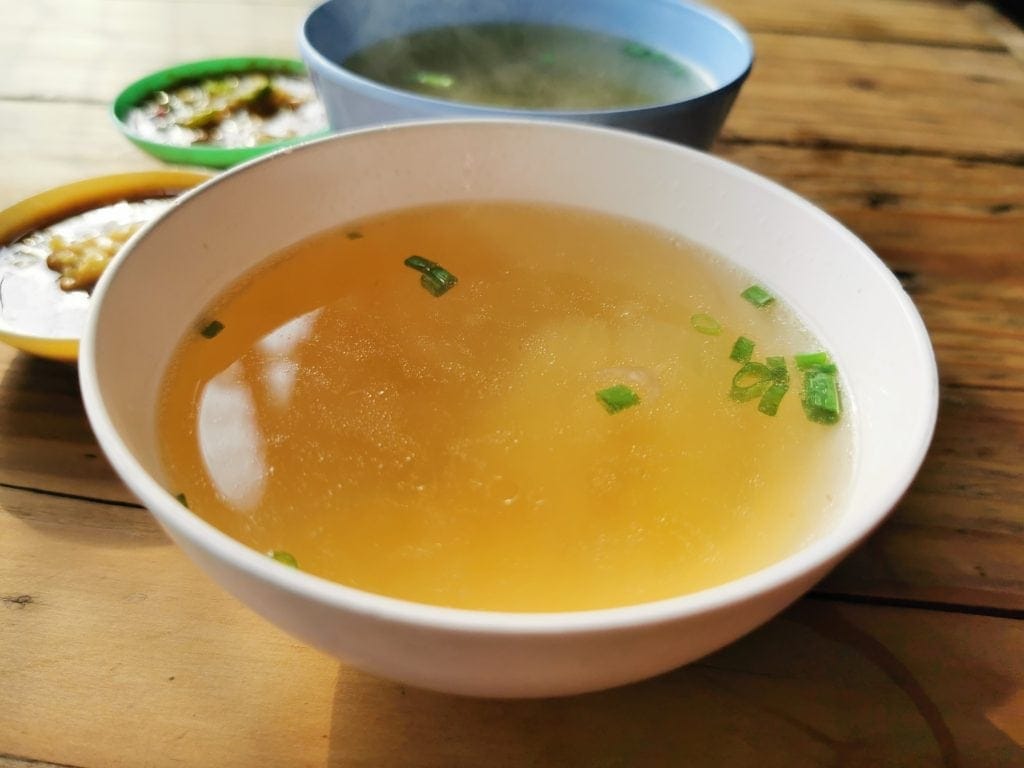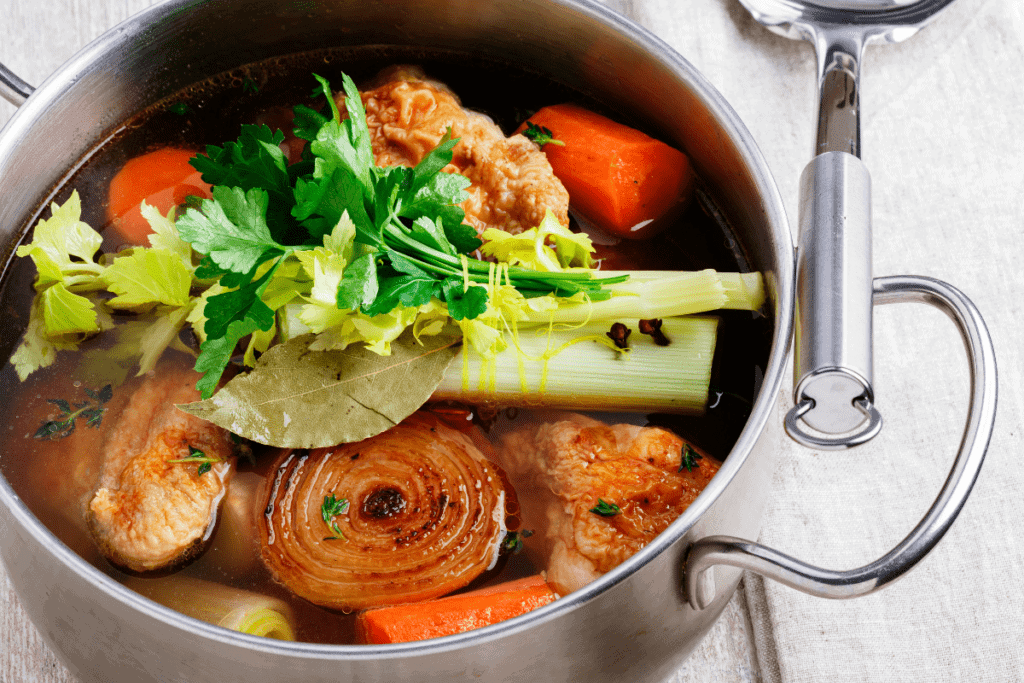Ideas for Left Over Beef Broth and Mastocytosis
When you have Mast Cell Activation Syndrome or Histamine Intolerance, bone broth is one of those "healthy" foods you may have to let go.
I've made bone broth so many times over my life…
I worked so hard to recover my health. And I tried anything I could get my hands on! Bone broth was one of the early things I came across over 15 years ago.
I first got into making bone broth when I was following the Weston A. Price Foundation. And their way of cooking traditional foods.
I'd make bone broth with all kinds of beef bones. I even used chicken feet! This was to get the maximum gelatin and collagen content for gut healing.
I had read how good it was supposed to be for healing the gut. And also for joint health.
Back then, I was dealing with all kinds of gut symptoms. But I was also struggling with pain in my joints. And difficulty walking.
I had fatigue, severe allergy issues, and anxiety. And at that point, no one really had any clue of what was happening with me – And I certainly didn't.
So, making bone broth was one of my early forays into healthier eating.
I had cleaned up the processed foods in my diet. And I'd taken out most of the sugar. And then I was also working on learning which foods were the most nutrient-dense.
Now, when I take something on, I take it on fully. So, I became a bit of a master when it comes to making bone broth.
I was also making ferments, my own kefir, and my own sourdough bread. So, I was doing quite a lot of cooking from that Weston A. Price perspective. And it's a really great way of eating for a lot of people.
I loved the philosophy of Weston A. Price. And I loved the focus on going back to our more traditional ways of eating. And for restoring our health.
I thought these would be the magic bullet for my health concerns.
The problem was that I didn't know that I had both Mast Cell Activation Syndrome and Histamine Intolerance. And these foods were a nightmare for mast cells and my histamine levels.
Eventually, I realized that the bone broth was actually triggering a lot of my symptoms.
And it made me so sad to give it up and let it go!
When I figured this out, I had to start going against what I thought was correct about health.
And I had to start opening my mind to what was right for my personal health and my unique situation.
So, what is it about bone broth? Why is it thought to be healthy?
And if it is healthy, why does it cause problems for Mast Cell Activation Syndrome and Histamine Intolerance?
That's what I'll be covering in this article.
What's the big deal with Bone Broth? What to know when you have Mast Cell Activation Syndrome or Histamine Intolerance

Bone broth can certainly be food that can help many people's gut and joints. (Unless you have Mast Cell Activation Syndrome, Histamine Intolerance, or Oxalate Issues like me).
There isn't a lot of solid scientific data on bone broth.
But, bone broth has many reported benefits.
Such as:
- Providing an easy-to-digest source of key vitamins and minerals
- Amino acids like glycine and arginine that can support the gut
- Soothing the gut lining and promoting healing
- Improving joint health due to its collagen
- Promoting restful sleep due to its glycine content
- High protein source
Bone broth is believed to help lower inflammation. And also provide amino acids needed by the gut lining. This is why it's often recommended for gut support protocols.
Many people who are dealing with conditions such as Inflammatory Bowel Disease (IBD) use bone broth to help their guts. This includes Crohn's Disease & Ulcerative Colitis. It's also recommended for Irritable Bowel Syndrome (IBS) and Small Intestine Bacterial Overgrowth (SIBO).
And bone broth has become a major health fad over the past few years. And a lot of people have done well with it.
However, it may lead to problems if you have Mast Cell Activation Syndrome or Histamine Intolerance. I'll explain why in the next section…
Problems with Bone Broth for Mast Cells & Histamine Levels – what to know when you have Mast Cell Activation Syndrome or Histamine Intolerance

The main reason why bone broth causes problems for those of us with Mast Cell Activation Syndrome or Histamine Intolerance is the histamine!
Meat or bones that are cooked for a long time release a fair amount of histamine into the broth.
And that's the very thing we're trying to avoid.
Beyond the histamine, there are other problems. Bone broth is rich in the amino acid glycine. And unfortunately, glycine can be converted to oxalates and glutamate in the body.
Unfortunately, it's still high histamine even if you cook it in the Instant Pot.
This is because pressure cooking can lower the lectins in foods. And it can certainly reduce the cooking time. However, it's not going to remove the oxalates or glutamates.
Wondering how you'll ever be able to make delicious soup again? Don't worry – In the next section, I'll give you an easy and tasty alternative!
What to do instead: Meat Broth: The Gut-Healing Bone Broth Alternative for people with Mast Cell Activation Syndrome or Histamine Intolerance

So, what can we make instead? Meat Broth!
Meat Broth is a wonderful alternative to slow cooked (histamine-rich) Bone Broth.
Are there still benefits, despite the shortened cooking time? Absolutely. Here are some benefits of meat broth:
- Still has the healing amino acids
- Supports the gut
- Very soothing to the digestive system
- Can drink it on its own or use it in recipes like these: Creamy Cauliflower Veggie Soup or Low Histamine Stroganoff
- Much lower in histamine
- Much lower in glycine (fewer oxalate/glutamate issues)
- Easy to make
- Can freeze in cubes for future meals
To make sure you're getting the benefits without the drawbacks of bone broth, there are a few things to keep in mind.
Next, I'll share a few cooking tips for keeping your meat broth low histamine.
Cooking Tips on Meat Broth: The Gut-Healing Bone Broth Alternative for people with Mast Cell Activation Syndrome or Histamine Intolerance

There are some tips I wanted to share with you before you get started on this recipe. To make sure you get the most out of this new technique for broth.
Here are a few cooking tips for meat broth:
- Use low histamine meat
- Buy pasture-raised meat and wild caught fish
- If you're going to make fish broth, make sure it's wild salmon flash-frozen right after it's caught. Vital Choice* has the lower histamine I've found.
- Buy meat as fresh as possible – frozen right after slaughter. Your best bet is your local farmer.If you don't have access to someone local, go with US Wellness Meats. Their pastured chicken, turkey, and rabbit that are frozen right after slaughter
- Try not to use beef, because 99% of beef bones are aged
- You can use chicken, turkey, lamb, etc.
- Don't let the meat or fish sit in the fridge after thawed. It will start to build histamine.
- Make a big batch and freeze for recipes or even just as a drink to soothe your tummy
- I really like these large 100% BPA free food grade silicone trays for freezing meat broth in. Each compartment is 1 cup. Which is the perfect size for a recipe or for drinking. They come with lids, so they're easy to stack:
- If you'd typically use black peppercorns in your broth, use pink peppercorns (Black pepper is high in histamine and oxalates).
- Use flat leaf parsley instead of curly parsley. Flat leaf parsley is lower in oxalates.
All right – Now you've got some notes from the chef. Let's get cooking!
Here's the recipe for low histamine, delicious Meat Broth…
Recipe for Meat Broth: The Gut-Healing Bone Broth Alternative for people with Mast Cell Activation Syndrome or Histamine Intolerance

The great thing about this recipe is that it's very versatile. You can add any combination of seasonings to adapt it for your soup recipe. Or even for your mood!
Not only that, but you can also easily double, triple, or quadruple this recipe.
Ingredients
- 2 cups low-histamine meat, thawed
- 2 cups water
- 2 stalks celery
- 1 onion, chopped (sub green onion tops for Low FODMAP)
- 2 cloves garlic (sub garlic infused olive oil for Low FODMAP)
- 1 teaspoon Redmond Real Salt
Optional Seasonings (pick any combo that work together for you):
If you are avoiding salicylates, then stick with cilantro, parsley, onion, and garlic.
- cilantro
- ginger
- lemongrass
- Italian parsley
- rosemary
- thyme
- oregano
- basil
Directions
- Heat water in a pan until boiling.
- Carefully add meat, vegetables, salt, and any seasonings you wish.
- Simmer for 20 minutes.
- Take off heat and let cool for 5 minutes.
- Strain and enjoy as is, freezing any leftovers. Or transfer to BPA-free ice cube trays and freeze for future recipes. Be careful not to burn yourself!
Ready to take the next step? Check out the Mast Cell Nervous System Reboot:

More Low Histamine Drinks
- Pumpkin Spice Drink – low lectin, low oxalate, low FODMAP
- Elderflower Sparkling Wine Cocktail (plus Mocktail option) – low FODMAP, low lectin, low oxalate
- Tulsi Rose Tea – low lectin, low oxalate, low FODMAP
- Mold Free Coffee
- Iced Hibiscus Tea
- Lower Histamine Wine Options
*Some links in this website are affiliate links, which means Mast Cell 360 may make a very small commission if you purchase through the link. It never costs you any more to purchase through the links, and we try to find the best deals we can. We only recommend products that we love and use personally or use in the Mast Cell360 practice. Any commissions help support the newsletter, website, and ongoing research so Mast Cell 360 can continue to offer you free tips, recipes, and info. Thank you for your support!
References for Meat Broth: The Gut-Healing Bone Broth Alternative For People With Mast Cell Activation Syndrome or Histamine Intolerance
Achamrah, N., Déchelotte, P., & Coëffier, M. (2017). Glutamine and the regulation of intestinal permeability: from bench to bedside. Current opinion in clinical nutrition and metabolic care, 20(1), 86–91. https://doi.org/10.1097/MCO.0000000000000339
Arora, B., Peacock, M., Robertson, W. G. (1989). Effect of glycine on urinary risk factors of kidney stone disease. Nutrition Research. 9(9), 1027-1031, ISSN 0271-5317. https://doi.org/10.1016/S0271-5317(89)80063-6.
Clegg, M. E., Ranawana, V., Shafat, A., & Henry, C. J. (2013). Soups increase satiety through delayed gastric emptying yet increased glycaemic response. European journal of clinical nutrition, 67(1), 8–11.https://doi.org/10.1038/ejcn.2012.152
Henrotin, Y., Mobasheri, A., & Marty, M. (2012). Is there any scientific evidence for the use of glucosamine in the management of human osteoarthritis?. Arthritis research & therapy, 14(1), 201. https://doi.org/10.1186/ar3657
Hsu, D. J., Lee, C. W., Tsai, W. C., & Chien, Y. C. (2017). Essential and toxic metals in animal bone broths. Food & nutrition research, 61(1), 1347478.https://doi.org/10.1080/16546628.2017.1347478
Kawai, N., Sakai, N., Okuro, M., Karakawa, S., Tsuneyoshi, Y., Kawasaki, N., Takeda, T., Bannai, M., & Nishino, S. (2015). The sleep-promoting and hypothermic effects of glycine are mediated by NMDA receptors in the suprachiasmatic nucleus. Neuropsychopharmacology : official publication of the American College of Neuropsychopharmacology, 40(6), 1405–1416. https://doi.org/10.1038/npp.2014.326
Leidy H. J. (2014). Increased dietary protein as a dietary strategy to prevent and/or treat obesity. Missouri medicine, 111(1), 54–58.
Scaldaferri, F., Lopetuso, L. R., Petito, V., Cufino, V., Bilotta, M., Arena, V., Stigliano, E., Maulucci, G., Papi, M., Emiliana, C. M., Poscia, A., Franceschi, F., Delogu, G., Sanguinetti, M., Spirito, M. D., Sgambato, A., & Gasbarrini, A. (2014). Gelatin tannate ameliorates acute colitis in mice by reinforcing mucus layer and modulating gut microbiota composition: Emerging role for 'gut barrier protectors' in IBD?. United European gastroenterology journal, 2(2), 113–122. https://doi.org/10.1177/2050640614520867
Razak, M. A., Begum, P. S., Viswanath, B., & Rajagopal, S. (2017). Multifarious Beneficial Effect of Nonessential Amino Acid, Glycine: A Review. Oxidative medicine and cellular longevity, 2017, 1716701. https://doi.org/10.1155/2017/1716701
Wijnands, K. A., Castermans, T. M., Hommen, M. P., Meesters, D. M., & Poeze, M. (2015). Arginine and citrulline and the immune response in sepsis. Nutrients, 7(3), 1426–1463. https://doi.org/10.3390/nu7031426
Yamadera, W., Inagawa, K., Chiba, S. et al. (2007). Glycine ingestion improves subjective sleep quality in human volunteers, correlating with polysomnographic changes. Sleep Biol. Rhythms 5, 126–131 https://doi.org/10.1111/j.1479-8425.2007.00262.x
Zdzieblik, D., Oesser, S., Gollhofer, A., & König, D. (2017). Improvement of activity-related knee joint discomfort following supplementation of specific collagen peptides. Applied physiology, nutrition, and metabolism = Physiologie appliquee, nutrition et metabolisme, 42(6), 588–595. https://doi.org/10.1139/apnm-2016-0390
Zhu, S., Huang, M., Feng, G., Miao, Y., Wu, H., Zeng, M., & Lo, Y. M. (2018). Gelatin versus its two major degradation products, prolyl-hydroxyproline and glycine, as supportive therapy in experimental colitis in mice. Food science & nutrition, 6(4), 1023–1031. https://doi.org/10.1002/fsn3.639
Source: https://mastcell360.com/meat-broth-the-gut-healing-bone-broth-alternative-for-people-with-mast-cell-activation-syndrome-or-histamine-intolerance-low-histamine-low-lectin-low-oxalate-low-fodmap-low-salicylate/
0 Response to "Ideas for Left Over Beef Broth and Mastocytosis"
Post a Comment